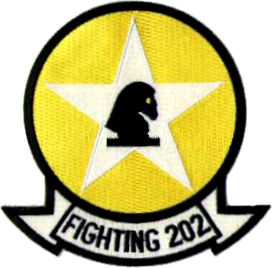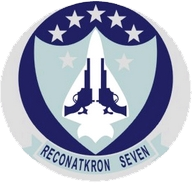
Strike Fighter Squadron 211 (VFA-211), nicknamed the "Fighting Checkmates", is an aviation unit of the United States Navy established in 1945. The squadron is based at Naval Air Station Oceana and is equipped with the Boeing F/A-18E Super Hornet.

The Strike Fighter Squadron 14 (VFA-14) "Tophatters" are a United States Navy fighter attack squadron based at Naval Air Station Lemoore. They fly the F/A-18E Super Hornet, and are the Navy's oldest active squadron, having formed in 1919. Their callsign is Camelot, and their tail code is NG.

Fighter Squadron 213 (VF-213)

Strike Fighter Squadron 102 (VFA-102) is a United States Navy Strike Fighter squadron based at Marine Corps Air Station Iwakuni. Their call sign is Diamond, with the tail code NF, and they fly the F/A-18F Super Hornet.

The VFA-201, Strike Fighter Squadron was an aviation unit of the United States Naval Reserve based at Naval Air Station Joint Reserve Base Fort Worth, Texas (USA). It was established in 1970 as part of Reserve Carrier Air Wing 20 (CVWR-20) and deactivated in 2007. During its service VFA-201 could be identified by the tail code "AF" and nose numbers (MODEX) in the "100" series, typically 100 to 113. The squadron's nickname was the Hunters.

Strike Fighter Squadron 32 (VFA-32), nicknamed the "Fighting Swordsmen" are a United States Navy strike fighter squadron presently flying the F/A-18F Super Hornet and based ashore at Naval Air Station Oceana. Their radio callsign is Gypsy and their tail code is AC. The Fighting Swordsmen of VFA-32 are the 2023 recipients of the Mutha Fighter Spirit Award, awarded annually at the Navy’s Strike Fighter Ball in Norfolk, VA.

VF-84, Fighter Squadron 84 was an aviation unit of the United States Navy. Originally established as VA-86 on 1 July 1955, it was immediately redesignated as VF-84 and was disestablished on 1 October 1995. It was the third US Navy squadron to be designated as VF-84. The squadron was nicknamed the Jolly Rogers and was based at NAS Oceana. It took the number but not the lineage of VF-84 the "Wolf Gang" and the insignia of VF-61 the Jolly Rogers.

Naval Air Station Lemoore or NAS Lemoore is a United States Navy base, located in Kings County and Fresno County, California, United States. Lemoore Station, a census-designated place, is located inside the base's borders.

A carrier air wing is an operational naval aviation organization composed of several aircraft squadrons and detachments of various types of fixed-wing and rotary-wing aircraft. Organized, equipped and trained to conduct modern US Navy carrier air operations while embarked aboard aircraft carriers, the various squadrons in an air wing have different but complementary missions, and provide most of the striking power and electronic warfare capabilities of a carrier battle group (CVBG). While the CVBG term is still used by other nations, the CVBG in US parlance is now known as a carrier strike group (CSG).

Strike Fighter Squadron 2 (VFA-2) also known as the "Bounty Hunters" is a United States Navy F/A-18F Super Hornet strike fighter squadron based at Naval Air Station Lemoore, California. Their tail code is NE and their callsign is "Bullet". They are attached to Carrier Air Wing 2 (CVW-2), a composite unit made up of a wide array of aircraft performing a variety of combat and support missions that deploy aboard the Carl Vinson.

Strike Fighter Squadron 101 (VFA-101), also known as the "Grim Reapers", was a United States Navy Fleet Replacement Squadron (FRS) based at Eglin AFB, Florida. After the West Coast FRS for the F-14 Tomcat, VF-124, was disestablished in the mid-1990s, VF-101 became the sole F-14 FRS. At the time it was based at NAS Oceana in Virginia. With the retirement of the F-14, VF-101 was deactivated in 2005. It was reactivated in 2012 and redesignated Strike Fighter Squadron 101 (VFA-101). It was one of two F-35C Lightning II FRS before being deactivated in 2019. It was based at Eglin AFB, Florida with the joint 33d Fighter Wing, as a subordinate unit of the U.S. Navy's Strike Fighter Wing, U.S. Pacific Fleet.

Fighter Squadron 124 or VF-124Gunfighters was a fleet replacement squadron (FRS) of the United States Navy. Originally established on 16 August 1948 as VF-53, it was redesignated VF-124 at NAS Moffett Field on 11 April 1958 due to a need for an increased number of flight training squadrons, itself necessary because of introduction of swept wing fighters into Navy service. In 1961, the squadron relocated to NAS Miramar, California, which would become the U.S. Pacific Fleet's Master Jet Base for fighter aircraft.

Strike Fighter Squadron 143 (VFA-143), also known as the "Pukin Dogs," is a United States Navy strike fighter squadron based at Naval Air Station Oceana, Virginia. The Pukin Dogs are an operational fleet squadron and flying the F/A-18E Super Hornet. They are currently attached to Carrier Air Wing One and USS Harry S Truman. They are currently at their homeport of NAS Oceana. Their radio callsign is Taproom.

Strike Fighter Squadron 154 (VFA-154), also known as the "Black Knights", is a United States Navy strike fighter squadron stationed at Naval Air Station Lemoore. The Black Knights are an operational fleet squadron flying the F/A-18F Super Hornet. They are currently attached to Carrier Air Wing Eleven and deployed aboard the aircraft carrier USS Theodore Roosevelt. Their tailcode is NH and their callsign is "Knight".

Fighter Squadron 202 (VF-202) nicknamed the Superheats was an aviation unit of the United States Naval Reserve initially based at Naval Air Station Dallas, Texas. Following that installation's BRAC-directed closure, the squadron relocated to nearby former Carswell Air Force Base, which was transferred to U.S. Navy control according to BRAC action and renamed Naval Air Station Joint Reserve Base Fort Worth / Carswell Field. VF-202 was established on 1 July 1970 as part of Reserve Carrier Air Wing 20 (CVWR-20), the U.S. Atlantic Fleet's reserve carrier air wing, and disestablished on 31 December 1994. During its service VF-202 could be identified by the tail code "AF" and nose numbers (MODEX) "200" through "213."

Fighter Squadron 301 (VF-301) was an aviation unit of the United States Naval Reserve in service from 1970 to 1994 at Naval Air Station (NAS) Miramar in southern California. The squadron's nickname was Devil's Disciples. In an early display of political correctness it was changed to Blazing Infernos when the Pope visited Los Angeles in the late 1980’s.

Fighter Squadron Composite 111 (VFC-111), also known as the "Sun Downers", is a United States Navy Reserve adversary squadron based at Naval Air Station Key West, Florida. Currently, it operates Northrop F-5N/F Tiger-IIs, of which most are single-seater F-5Ns and one twin-seater F-5F, the "FrankenTiger".

RVAH-7 was a reconnaissance attack (heavy) squadron of the U.S. Navy. Originally established as Composite Squadron Seven (VC-7) on 10 August 1950, it was redesignated as Heavy Attack Squadron Seven (VAH-7) on 1 November 1955 and was redesignated again as Reconnaissance Attack (Heavy) Squadron Seven (RVAH-7) on 1 December 1964. The squadron was disestablished on 28 September 1979.

Fighter Squadron 194 or VF-194 was a short-lived aviation unit of the United States Navy established on 1 December 1986 and disestablished on 30 April 1988. It was the fourth US Navy squadron to be designated VF-194.






















